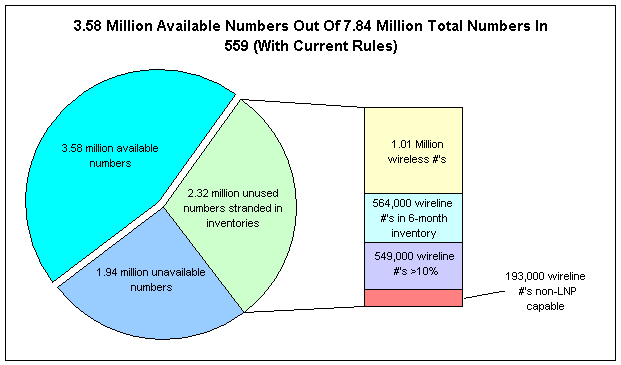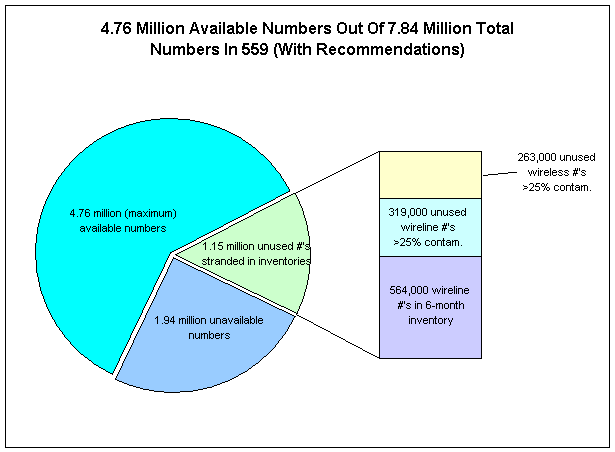BACKGROUND
The 559 area code contains approximately 7.84 million telephone numbers available for consumer use. These numbers are available to telecommunications companies that obtain the numbers from the North American Numbering Plan Administrator (NANPA), 1 and in turn, assign the numbers to their customers for their immediate use. Alternatively, companies may reserve numbers for future use, or retain numbers for some internal (administrative) use. Some companies provide blocks of numbers to resellers or "dealers", which then assign those numbers to customers. The FCC deems numbers that companies allocate to resellers to be "intermediate" numbers. In addition, each assigned number, after disconnection, must "age" during a transition period before assignment to the next customer. Many companies have inventories of numbers in the "aging" process. Finally, some numbers are not available for public use, as they have been set aside for emergency purposes, for technical network support, or for other reasons. The FCC has defined numbers in these five categories - assigned, administrative, reserved, intermediate, or aging - as unavailable, either because they are already in use or are designated for some present or future use.
FINDINGS
TD's analysis shows that of the 5.90 million available numbers, approximately 2.64 million have been set aside by the CPUC to use in a lottery for companies seeking numbers. Companies possess the remaining unused 3.26 million numbers. Wireline carriers, such as Pacific Bell and many competitive local exchange carriers, hold roughly 2.25 million available numbers, while wireless carriers2 hold approximately 1.01 million available numbers.
At the same time, the 559 study finds that under FCC rules about 2.32 million numbers cannot be contributed to the 559 number lottery, nor can they be contributed to the future 559 number pool for reassignment to other companies. The FCC has determined that wireless carriers do not have to participate in number pooling at this time.3 In addition, the FCC has determined that the CPUC may only require wireline carriers to contribute to a number pool those blocks of 1,000 numbers that are 10% or less contaminated,4 meaning those blocks in which only 100 or fewer numbers are unavailable. However, wireline carriers may also keep a portion of the 10% or less contaminated blocks if they need to use those blocks within six months. The study further finds that of the 5.90 million numbers not in use, a maximum of 4.76 million numbers5 could be made available to companies through pooling if a) the companies donated blocks with higher contamination levels to the pool, and b) wireless carriers were required to participate in the 559 number pool. The first table below illustrates the current distribution of numbers assuming wireline pooling at 10% contamination. The second table shows the distribution that would occur if all the recommendations in this report were implemented.

In both graphs, numbers may not add to 100% due to rounding.

Finally, the study notes that companies identify 1.94 million numbers as unavailable. TD staff recommends specific measures the CPUC can employ to ensure that companies use those "unavailable" numbers more efficiently. Given the near doubling of the number of area codes in California, from 1996 to 1999, this vital public resource should be used as efficiently and effectively as possible. The CPUC and the telecommunications industry should strive to minimize the quantity of numbers left stranded in company inventories. The 559 Area Code Report recommendations are summarized in Appendix I.
1 NANPA is a role performed by NeuStar, Inc. The FCC chose NeuStar, formerly Lockheed Martin, to perform the functions of numbering administration and area code changes nationwide. 2 Including Type 1 Carriers. Type 1 numbers are described in Chapter 2, Sec. D. 4.a. 3 At present, only wireline carriers are required to participate in number pooling. The FCC has granted most wireless carriers an extension of time, until November, 2002, to implement the technology that will support number pooling. The FCC has permanently exempted paging companies from implementing the technology necessary to pool. 4 The percentage of numbers in use in a particular block of 1,000 numbers is referred to as the "contamination" level. 5 This assumes that companies' six-month inventory needs would be satisfied out of the unused numbers in the blocks greater than 25% contaminated.